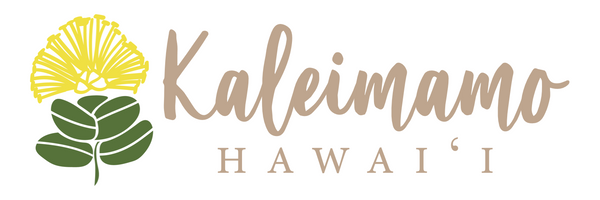Kalo
Hāloanakalaukapalili was the stillborn child of Wākea and Hoʻohōkūkalani. From his grave grew a kalo (taro) plant. Wākea and Hoʻohōkūkalani’s second child, Hāloa, was the first Hawaiian from whom we all descend. Kalo has sustained Hawaiians for generations upon generations. In turn, we care for Kalo, our sacred ancestor, and the ‘āina (land) that supports us all.

Native Hawaiians have grown kalo for a thousand years. Historically, there were over 400 varieties of kalo but today, there are only about 80 native varieties remaining. Kalo is grown in irrigated flooded fields, known as lo‘i, and dry-land fields, called mala. Huli (cuttings) taken from previously harvested kalo are planted. After 8-14 months, the mature kalo are harvested by hand. The lūʻau (leaves) and stems are cooked and used in a variety of dishes, including stew and laulau. The corm (also called kalo) is commonly cooked and pounded into a paste called paʻi ʻai, which becomes poi when mixed with water. Cooked kalo is also cut into pieces and eaten. Kalo is also grinded and mixed with coconut milk and sugar to make a pudding-like dessert called kūlolo.


Lo‘i kalo are renowned as a premiere example of sustainable agriculture and indigenous innovation. These agricultural systems utilize a network of ‘auwai (ditches) to direct wai (water) from a nearby stream or spring through the lo‘i and then back into the stream. In the process, lo‘i provide habitats for native water birds, such as koloa maoli, ‘alae, aeʻo, and ʻaukuʻu, and other aquatic life, such as ʻōpae, āholehole, and ʻoʻopu. Hawaiians grew a variety of other crops on the banks of lo‘i in a style of permaculture and there are also some examples of loʻi also being used for aquaculture. Lo‘i also help slow the flow of water, maximizing groundwater recharge and mitigating flooding in times of heavy rain.
Recognizing the importance of wai to the natural ecosystem and to those living downstream, Hawaiians carefully managed their loʻi diversions to maintain consistent stream flow. Today, more modern diversions have cut off mauka to makai (mountain to ocean) stream flow, negatively impacting traditional loʻi kalo farming and the health of native ecosystems across Hawai‘i.


This print was created by fellow Native Hawaiian-owned business, The Keiki Department.
For more information on kalo, check out Nohoʻana Farm, Hui Kū Maoli Ola, and Bishop Museum.
